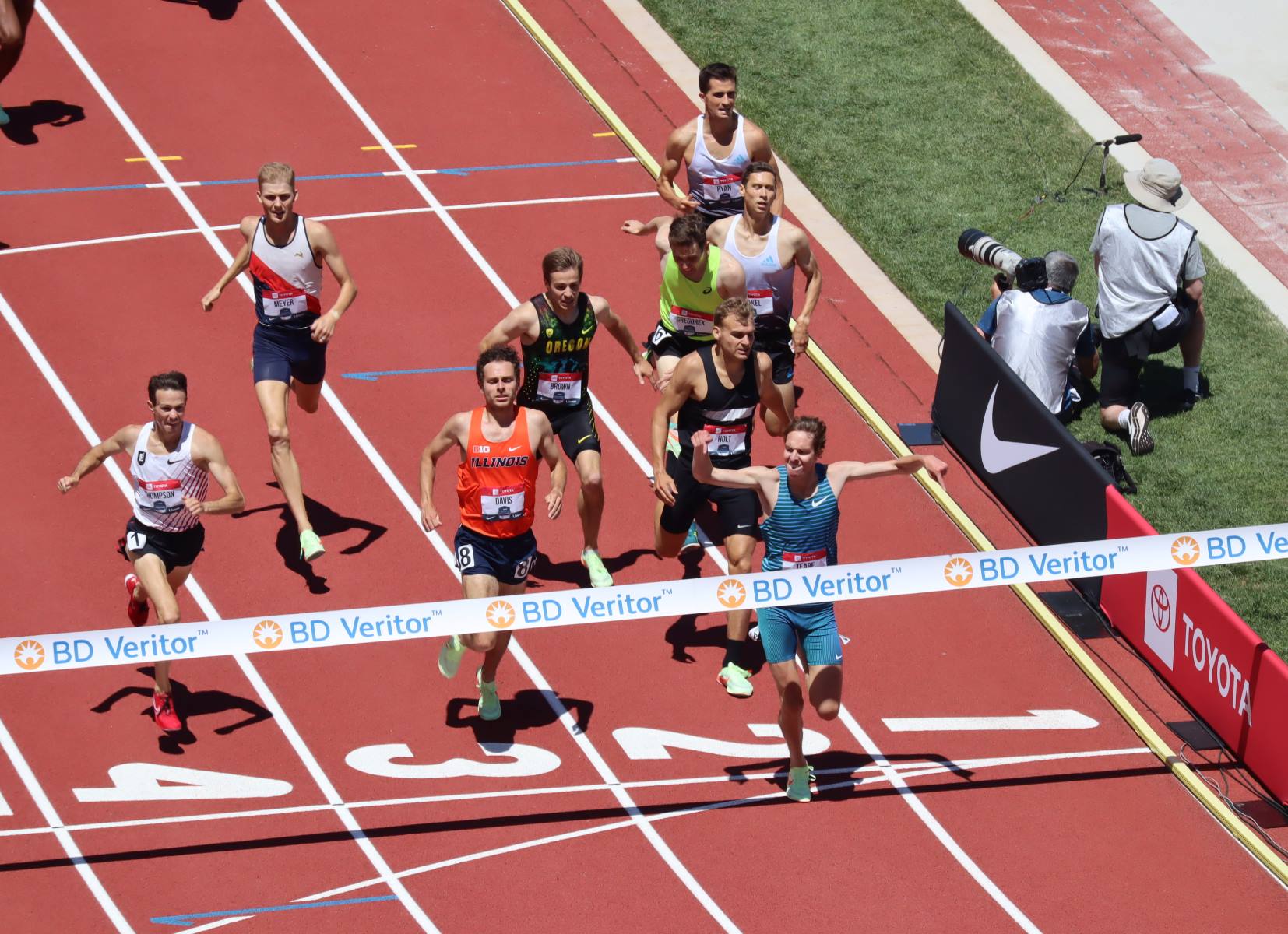Home>Misc>Featured>Which System Provides An Instant Energy Source When A Runner First Begins To Sprint?


Featured
Which System Provides An Instant Energy Source When A Runner First Begins To Sprint?
Modified: October 26, 2023
Discover the Featured System Used by Runners for a Quick Energy Boost When Sprinting
Introduction
When a runner first begins to sprint, they need a quick and immediate energy source to fuel their muscles. This energy system kicks in to supply the necessary power for short bursts of intense activity. Understanding how this energy system works is crucial for athletes and fitness enthusiasts who engage in activities that require bursts of speed and power.
There are two main energy systems that the body relies on during exercise: the aerobic system and the anaerobic system. While the aerobic system utilizes oxygen to produce energy over a longer duration, the anaerobic system provides an instant energy source for high-intensity efforts, such as sprinting. In this article, we will focus on the anaerobic system and specifically on the phosphocreatine system, which is the primary energy system utilized during the initial stages of sprinting.
The phosphocreatine system is responsible for providing immediate energy for intense, short-duration activities. It is a fast-acting system that helps replenish the ATP (adenosine triphosphate) stores in the muscles, allowing for repeated quick bursts of energy. Understanding how this system works and how to optimize its activation can greatly improve an athlete’s sprinting performance.
In the subsequent sections, we will delve into the details of the phosphocreatine system and explore how it is activated to provide an instant energy source for sprinters. By understanding the intricacies of this energy system, athletes can strategically train and fuel their bodies to maximize their sprinting ability and achieve optimal performance.
Aerobic vs. Anaerobic Systems
Before diving into the specifics of the phosphocreatine system, it is essential to differentiate between the two main energy systems at play during exercise: the aerobic and anaerobic systems.
The aerobic system, also known as oxidative metabolism, is the primary energy system used for low to moderate intensity activities that can be sustained for longer durations. This system relies on oxygen to break down glucose and fatty acids, producing ATP as a source of energy. The aerobic system is highly efficient and can provide a steady supply of energy for activities such as jogging, cycling, or long-distance running.
In contrast, the anaerobic system is utilized during high-intensity activities that demand immediate bursts of power. Unlike the aerobic system, the anaerobic system does not require oxygen to generate energy. Instead, it relies on stored energy sources within the muscles to produce ATP. While the anaerobic system is not as efficient as the aerobic system in terms of producing ATP, it is capable of providing energy rapidly, making it crucial for activities like sprinting, weightlifting, and other explosive movements.
The anaerobic system can be further divided into two pathways: the phosphocreatine system and the glycolytic system. The phosphocreatine system is responsible for providing energy during the initial stages of high-intensity exercise, while the glycolytic system takes over for activities lasting longer than a few minutes.
Understanding the differences between these energy systems is vital for athletes to tailor their training and nutrition strategies accordingly. While endurance athletes such as marathon runners focus more on developing their aerobic capacity, sprinters and power athletes place greater emphasis on optimizing the anaerobic system to generate quick bursts of energy.
In the next section, we will delve deeper into the phosphocreatine system, which is the primary energy system utilized during the first few seconds of sprinting.
Sprinting and Immediate Energy Source
Sprinting is a demanding and explosive activity that requires a rapid and immediate energy source to power the muscles. When a runner accelerates from a stationary position or increases their speed during a sprint, the body relies on the anaerobic energy system to provide the necessary fuel.
During sprinting, the demand for energy exceeds what can be supplied solely by the aerobic system. To meet this demand, the body taps into the immediate energy sources available within the muscles. This is where the phosphocreatine system comes into play.
The phosphocreatine system, also known as the ATP-PC system, provides energy for approximately 10 to 15 seconds of maximal exertion. It relies on the conversion of stored phosphocreatine into ATP, which is then used as fuel by the muscles.
ATP, or adenosine triphosphate, is often referred to as the “energy currency” of the body. It is essential for muscle contraction and any other cellular activity that requires energy. However, the body stores only a limited amount of ATP, enough to sustain high-intensity exercise for a few seconds.
Fortunately, the phosphocreatine system acts as a backup energy system that replenishes ATP levels in the muscles. This system works by breaking down phosphocreatine, a high-energy compound stored in the muscles, to produce ATP. The conversion of phosphocreatine to ATP occurs rapidly and allows for immediate energy availability to support the intense muscle contractions required for sprinting.
It’s important to note that the phosphocreatine system, although effective in providing quick energy, has limited capacity and is quickly depleted. After the initial 10 to 15 seconds of sprinting, the body will rely on other energy systems, such as the glycolytic system, to sustain the activity.
Understanding the role of the phosphocreatine system in sprinting highlights the significance of explosive power and quick bursts of energy in this type of activity. Sprinters who can optimize the activation and efficiency of this energy system can achieve faster sprint times and improved overall performance.
In the next section, we will explore how the phosphocreatine system is activated during sprinting and what factors can influence its effectiveness.
The Phosphocreatine System
The phosphocreatine system, also known as the ATP-PC system, is an anaerobic energy system that plays a crucial role in providing immediate energy for high-intensity activities like sprinting. This system relies on the stored energy in the form of phosphocreatine (PC), which is abundant in the muscles.
Phosphocreatine is a high-energy compound that is naturally synthesized in the body and stored in the muscle cells. Its primary purpose is to rapidly regenerate ATP during short-duration, high-intensity activities such as sprinting, weightlifting, and jumping.
When sprinting, the demand for ATP increases significantly as the muscles contract forcefully and repeatedly. The phosphocreatine system steps in to replenish ATP levels by donating a phosphate group from phosphocreatine to ADP (adenosine diphosphate), converting it back into ATP.
This process is facilitated by the enzyme creatine kinase, which helps catalyze the breakdown of phosphocreatine and the subsequent synthesis of ATP. The phosphate group from phosphocreatine attaches to ADP, creating ATP, which can then be used as fuel for muscle contractions.
Unlike the aerobic system, which requires oxygen to produce ATP, the phosphocreatine system can supply energy without the need for oxygen. This makes it the go-to energy system during the initial stages of high-intensity exercise when oxygen supply to the muscles is limited.
The phosphocreatine system is highly efficient, producing ATP rapidly and allowing for quick bursts of energy. However, it has a limited capacity and can only sustain high-intensity exercise for a short period. The duration of the energy supply provided by the phosphocreatine system typically lasts around 10 to 15 seconds.
Optimizing the phosphocreatine system is crucial for sprinters aiming to improve their performance. Increasing the concentration of phosphocreatine in the muscles through specific training methods, such as high-intensity interval training and resistance training, can enhance the system’s ability to regenerate ATP and provide energy during sprints.
In addition to training adaptations, nutrition also plays a significant role in supporting the phosphocreatine system. Consuming a diet rich in creatine, the precursor to phosphocreatine, can increase muscle stores of creatine and phosphocreatine, ensuring a readily available energy source for sprinting.
Understanding the intricacies of the phosphocreatine system and how to optimize its function through training and nutrition can lead to improvements in sprinting performance. In the next section, we will explore the factors that influence the activation of the phosphocreatine system during sprinting.
Activation of the Phosphocreatine System
The activation of the phosphocreatine system during sprinting relies on several factors that contribute to maximizing its efficiency and effectiveness. Understanding these factors can help athletes improve their sprinting performance and optimize the energy supply from this anaerobic system.
One crucial factor in activating the phosphocreatine system is the intensity and duration of the sprint. Short, explosive sprints lasting around 10 to 15 seconds primarily rely on the phosphocreatine system for immediate energy. The higher the intensity and the shorter the sprint, the more the body will rely on this system to meet the energy demands.
Interval training, specifically high-intensity interval training (HIIT), is an effective method to train and enhance the phosphocreatine system. By alternating between short bursts of maximum effort sprinting and recovery periods, HIIT stimulates the utilization and replenishment of ATP through the phosphocreatine system. This type of training helps improve the capacity of the system and enhances anaerobic performance.
Another factor that influences the activation of the phosphocreatine system is the muscles’ creatine and phosphocreatine stores. Creatine, obtained through diet or supplements, contributes to the formation of phosphocreatine in the muscles. Consuming an adequate amount of creatine can help increase the levels of phosphocreatine available for energy production during sprints. However, it is essential to consult with a healthcare professional or sports nutritionist before starting any creatine supplementation.
The recovery period between sprints is also critical for the activation of the phosphocreatine system. During this recovery phase, the body replenishes the depleted phosphocreatine stores in the muscles. Giving sufficient rest and recovery time allows for the resynthesis of phosphocreatine, ensuring an available energy source for subsequent sprints.
In addition to training and recovery, proper nutrition plays a vital role in activating and supporting the phosphocreatine system. Consuming a well-balanced diet that includes sources of creatine, such as lean meats, fish, and poultry, can help increase muscle creatine and phosphocreatine levels.
Hydration is also crucial for the optimal functioning of the phosphocreatine system. Water plays a role in numerous metabolic processes, including energy production. Adequate hydration supports the transfer of energy substrates and helps maintain optimal muscle function during sprinting.
Taking into consideration these factors – intensity and duration of sprints, interval training, creatine supplementation, proper recovery, and hydration – can enhance the activation of the phosphocreatine system during sprinting. By maximizing the efficiency of this energy system, athletes can improve their sprinting performance and achieve their athletic goals.
Conclusion
The phosphocreatine system is a vital energy system that provides an immediate energy source for intense activities like sprinting. Understanding how this system works and optimizing its activation can greatly enhance sprinting performance for athletes.
Sprinting relies on the anaerobic energy systems, namely the phosphocreatine system, which utilizes stored phosphocreatine to rapidly replenish ATP levels within the muscles. This allows for quick bursts of energy during the initial stages of high-intensity exercise.
Different factors influence the activation of the phosphocreatine system. Factors such as the intensity and duration of the sprint, the effectiveness of high-intensity interval training (HIIT), the availability of creatine in the muscles, appropriate recovery time, and adequate hydration all play a crucial role in optimizing this energy system.
By implementing proper training strategies that focus on high-intensity interval training, along with ensuring adequate creatine stores through nutrition or supplementation, sprinters can enhance the functioning of the phosphocreatine system. This can lead to improved energy output, increased sprinting speed, and overall better performance.
It is important to note that optimizing the phosphocreatine system is just one aspect of sprinting performance. Sprinters should also consider other factors such as technique, strength training, and overall conditioning to achieve their full potential.
In conclusion, the phosphocreatine system serves as a crucial energy source during the initial stages of sprinting. Understanding how to activate and optimize this system allows athletes to harness the power of quick bursts of energy, facilitating improved sprinting performance and helping them reach their athletic goals.







